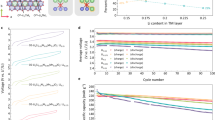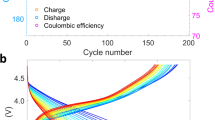Abstract
Ordered layered structures serve as essential components in lithium (Li)-ion cathodes1,2,3. However, on charging, the inherently delicate Li-deficient frameworks become vulnerable to lattice strain and structural and/or chemo-mechanical degradation, resulting in rapid capacity deterioration and thus short battery life2,4. Here we report an approach that addresses these issues using the integration of chemical short-range disorder (CSRD) into oxide cathodes, which involves the localized distribution of elements in a crystalline lattice over spatial dimensions, spanning a few nearest-neighbour spacings. This is guided by fundamental principles of structural chemistry and achieved through an improved ceramic synthesis process. To demonstrate its viability, we showcase how the introduction of CSRD substantially affects the crystal structure of layered Li cobalt oxide cathodes. This is manifested in the transition metal environment and its interactions with oxygen, effectively preventing detrimental sliding of crystal slabs and structural deterioration during Li removal. Meanwhile, it affects the electronic structure, leading to improved electronic conductivity. These attributes are highly beneficial for Li-ion storage capabilities, markedly improving cycle life and rate capability. Moreover, we find that CSRD can be introduced in additional layered oxide materials through improved chemical co-doping, further illustrating its potential to enhance structural and electrochemical stability. These findings open up new avenues for the design of oxide cathodes, offering insights into the effects of CSRD on the crystal and electronic structure of advanced functional materials.
This is a preview of subscription content, access via your institution
Access options
Access Nature and 54 other Nature Portfolio journals
Get Nature+, our best-value online-access subscription
$29.99 / 30 days
cancel any time
Subscribe to this journal
Receive 51 print issues and online access
$199.00 per year
only $3.90 per issue
Buy this article
- Purchase on Springer Link
- Instant access to full article PDF
Prices may be subject to local taxes which are calculated during checkout




Similar content being viewed by others
Data availability
The data that support the findings of this study are available in the main text and Supplementary Information. All relevant data are available from the corresponding authors upon request.
References
Goodenough, J. B. Evolution of strategies for modern rechargeable batteries. Acc. Chem. Res. 46, 1053–1061 (2013).
Mizushima, K., Jones, P. C., Wiseman, P. J. & Goodenough, J. B. LixCoO2 (0 < x ≤ 1): a new cathode material for batteries of high energy density. Mater. Res. Bull. 15, 783–789 (1980).
Reed, J., Ceder, G. & Van Der Ven, A. Layered-to-Spinel Phase Transition in LixMnO2. Electrochem. Solid-State Lett. 4, A78 (2001).
Reimers, J. N. & Dahn, J. R. Electrochemical and in situ X‐ray diffraction studies of lithium intercalation in LixCoO2. J. Electrochem. Soc. 139, 2091–2097 (1992).
Elliott, S. R. in Physics of Amorphous Materials 2nd edn 139–151 (Longman, 1990).
Greer, A. L. in Intermetallic Compounds—Principles and Practice Vol. 1 (eds Westbrook, J. H. & Fleischer, R. L.) 731–754 (Wiley, 1995).
Sheng, H. W., Luo, W. K., Alamgir, F. M., Bai, J. M. & Ma, E. Atomic packing and short-to-medium-range order in metallic glasses. Nature 439, 419–425 (2006).
Zhang, N. et al. The missing boundary in the phase diagram of PbZr1−xTixO3. Nat. Commun. 5, 5231 (2014).
Yang, T. et al. Multicomponent intermetallic nanoparticles and superb mechanical behaviors of complex alloys. Science 362, 933–937 (2018).
Zhang, R. et al. Short-range order and its impact on the CrCoNi medium-entropy alloy. Nature 581, 283–287 (2020).
Lee, J. et al. Unlocking the potential of cation-disordered oxides for rechargeable lithium batteries. Science 343, 519–522 (2014).
Zhao, C. et al. Rational design of layered oxide materials for sodium-ion batteries. Science 370, 708–711 (2020).
Cartledge, G. H. Studies on the periodic system. I. The ionic potential as a periodic function. J. Am. Chem. Soc. 50, 2855–2863 (1928).
Wang, Q. et al. Designing lithium halide solid electrolytes. Nat. Commun. 15, 1050 (2024).
Antaya, M., Cearns, K., Preston, J. S., Reimers, J. N. & Dahn, J. R. In situ growth of layered, spinel, and rock‐salt LiCoO2 by laser ablation deposition. J. Appl. Phys. 76, 2799–2806 (1994).
Kanno, R. et al. Synthesis, structure, and electrochemical properties of a new lithium iron oxide, LiFeO2, with a corrugated layer structure. J. Electrochem. Soc. 143, 2435–2441 (1996).
Sakurai, Y., Arai, H. & Yamaki, J. Preparation of electrochemically active α-LiFeO2 at low temperature. Solid State Ion. 113-115, 29–34 (1998).
Werder, D. J., Chen, C. H., Cava, R. J. & Batlogg, B. Diffraction evidence for oxygen-vacancy ordering in annealed Ba2YCu3O7−δ (0.3 ≤ δ ≤ 0.4) superconductors. Phys. Rev. B 37, 2317–2319 (1988).
Li, L. et al. Evolution of short-range order and its effects on the plastic deformation behavior of single crystals of the equiatomic Cr-Co-Ni medium-entropy alloy. Acta Mater. 243, 118537 (2023).
Yang, J. H., Kim, H. & Ceder, G. Insights into layered oxide cathodes for rechargeable batteries. Molecules 26, 3173 (2021).
Rossen, E., Reimers, J. N. & Dahn, J. R. Synthesis and electrochemistry of spinel LT-LiCoO2. Solid State Ionics 62, 53–60 (1993).
Gummow, R. J., Thackeray, M. M., David, W. I. F. & Hull, S. Structure and electrochemistry of lithium cobalt oxide synthesised at 400 °C. Mater. Res. Bull. 27, 327–337 (1992).
Hua, W. et al. Chemical and structural evolution during the synthesis of layered Li(Ni,Co,Mn)O2 oxides. Chem. Mater. 32, 4984–4997 (2020).
Duffiet, M. et al. Probing Al distribution in LiCo0.96Al0.04O2 materials using 7Li, 27Al, and 59Co MAS NMR combined with synchrotron X-ray diffraction. Inorg. Chem. 59, 2890–2899 (2020).
Zhao, C., Avdeev, M., Chen, L. & Hu, Y.-S. An O3-type oxide with low sodium content as the phase-transition-free anode for sodium-ion batteries. Angew. Chem. Int. Ed. 57, 7056–7060 (2018).
Ménétrier, M., Saadoune, I., Levasseur, S. & Delmas, C. The insulator-metal transition upon lithium deintercalation from LiCoO2: electronic properties and 7Li NMR study. J. Mater. Chem. 9, 1135–1140 (1999).
Zhang, J.-N. et al. Trace doping of multiple elements enables stable battery cycling of LiCoO2 at 4.6 V. Nat. Energy 4, 594–603 (2019).
Yang, X. et al. Pushing lithium cobalt oxides to 4.7 V by lattice-matched interfacial engineering. Adv. Energy Mater. 12, 2200197 (2022).
Yang, X. et al. Enabling stable high-voltage LiCoO2 operation by using synergetic interfacial modification strategy. Adv. Funct. Mater. 30, 2004664 (2020).
Shao-Horn, Y., Levasseur, S., Weill, F. & Delmas, C. Probing lithium and vacancy ordering in O3 layered Lix CoO2 (x ≈ 0.5): an electron diffraction study. J. Electrochem. Soc. 150, A366 (2003).
Chen, Z., Lu, Z. & Dahn, J. R. Staging phase transitions in LixCoO2. J. Electrochem. Soc. 149, A1604 (2002).
Amatucci, G. G., Tarascon, J. M. & Klein, L. C. CoO2, the end member of the LixCoO2 solid solution. J. Electrochem. Soc. 143, 1114–1123 (1996).
Lee, J. et al. Reversible Mn2+/Mn4+ double redox in lithium-excess cathode materials. Nature 556, 185–190 (2018).
Ji, H. et al. Ultrahigh power and energy density in partially ordered lithium-ion cathode materials. Nat. Energy 5, 213–221 (2020).
Reed, J. & Ceder, G. Role of electronic structure in the susceptibility of metastable transition-metal oxide structures to transformation. Chem. Rev. 104, 4513–4534 (2004).
Zsoldos, E. S., Cormier, M. M. E., Ball, M., Rathore, D. & Dahn, J. R. The effects of small amounts of cobalt in LiNi1-xCoxO2 on lithium-ion diffusion. J. Electrochem. Soc. 170, 070502 (2023).
Wang, Q. et al. Fast-charge high-voltage layered cathodes for sodium-ion batteries. Nat. Sustain. 7, 338–347 (2024).
Yabuuchi, N. et al. Origin of stabilization and destabilization in solid-state redox reaction of oxide ions for lithium-ion batteries. Nat. Commun. 7, 13814 (2016).
Fu, A. et al. Enabling interfacial stability of LiCoO2 batteries at an ultrahigh cutoff voltage ≥ 4.65 V via a synergetic electrolyte strategy. J. Mater. Chem. A 11, 3703–3716 (2023).
Kresse, G. & Furthmüller, J. Efficient iterative schemes for ab initio total-energy calculations using a plane-wave basis set. Phys. Rev. B 54, 11169–11186 (1996).
Kresse, G. & Hafner, J. Ab initio molecular dynamics for liquid metals. Phys. Rev. B 47, 558–561 (1993).
Blöchl, P. E. Projector augmented-wave method. Phys. Rev. B 50, 17953–17979 (1994).
Perdew, J. P., Ernzerhof, M. & Burke, K. Rationale for mixing exact exchange with density functional approximations. J. Chem. Phys. 105, 9982–9985 (1996).
Dudarev, S. L., Botton, G. A., Savrasov, S. Y., Humphreys, C. J. & Sutton, A. P. Electron-energy-loss spectra and the structural stability of nickel oxide: an LSDA+U study. Phys. Rev. B 57, 1505–1509 (1998).
Wang, L., Maxisch, T. & Ceder, G. Oxidation energies of transition metal oxides within the GGA + U framework. Phys. Rev. B 73, 195107 (2006).
Wolverton, C. Crystal structure and stability of complex precipitate phases in Al–Cu–Mg–(Si) and Al–Zn–Mg alloys. Acta Mater. 49, 3129–3142 (2001).
Urban, A., Matts, I., Abdellahi, A. & Ceder, G. Computational design and preparation of cation-disordered oxides for high-energy-density Li-ion batteries. Adv. Energy Mater. 6, 1600488 (2016).
Yao, Z. et al. Revealing the conversion mechanism of transition metal oxide electrodes during lithiation from first-principles. Chem. Mater. 29, 9011–9022 (2017).
Hart, G. L. W., Nelson, L. J. & Forcade, R. W. Generating derivative structures at a fixed concentration. Comput. Mater. Sci. 59, 101–107 (2012).
Hart, G. L. W. & Forcade, R. W. Algorithm for generating derivative structures. Phys. Rev. B 77, 224115 (2008).
Momma, K. & Izumi, F. VESTA 3 for three-dimensional visualization of crystal, volumetric and morphology data. J. Appl. Crystallogr. 44, 1272–1276 (2011).
Acknowledgements
This work is supported by the Netherlands Organization for Scientific Research (NWO) under the VICI (No. 16122), National Nature Science Foundation of China (No. 51991344, 52373228 and 12105372), National Key R&D Program of China (No. 2021YFA1202802), Key-Area Research and Development Program of Guangdong Province (No. 2023B0909030001).
Author information
Authors and Affiliations
Contributions
Q.W. and C.Z. conceived the idea and designed the experiments. M.W. and B.L. supervised the research. Q.W., C.Z. and D.Z. performed the synthesis, material characterization and electrochemical measurements. Z.Y. performed the DFT calculation and interpreted the data with Q.W.; J.W. and X.B. performed the STEM and EELS measurements and analysed the data with Q.W.; C.Z. and H.G. collected the NPD data and interpreted the data with Q.W.; C.L conducted the solid-state NMR measurements and interpreted the data with Q.W. All authors participated in analysing and discussing the results. Q.W., C.Z., M.W., Z.Y., B.L. and H.L. prepared the Article with the input of all authors.
Corresponding authors
Ethics declarations
Competing interests
The authors declare no competing interests.
Peer review
Peer review information
Nature thanks Marca Doeff and the other, anonymous, reviewer(s) for their contribution to the peer review of this work.
Additional information
Publisher’s note Springer Nature remains neutral with regard to jurisdictional claims in published maps and institutional affiliations.
Extended data figures and tables
Supplementary information
Rights and permissions
Springer Nature or its licensor (e.g. a society or other partner) holds exclusive rights to this article under a publishing agreement with the author(s) or other rightsholder(s); author self-archiving of the accepted manuscript version of this article is solely governed by the terms of such publishing agreement and applicable law.
About this article
Cite this article
Wang, Q., Yao, Z., Wang, J. et al. Chemical short-range disorder in lithium oxide cathodes. Nature 629, 341–347 (2024). https://doi.org/10.1038/s41586-024-07362-8
Received:
Accepted:
Published:
Issue Date:
DOI: https://doi.org/10.1038/s41586-024-07362-8
Comments
By submitting a comment you agree to abide by our Terms and Community Guidelines. If you find something abusive or that does not comply with our terms or guidelines please flag it as inappropriate.



